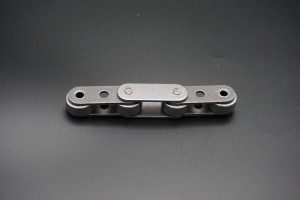On the grand stage of modern industry, there is a seemingly simple but crucial component that silently supports the operation of countless machines, that is, the roller chain. This article will take you deep into the world of roller chains, from its working principle to its indispensable role in modern industry. Let us explore the mystery of this industrial heart together.
Origin and evolution of roller chains
The origin of roller chains can be traced back to 180 BC, when China invented a device called “chain drive” for lifting water wheels. However, the real roller chain was invented by Charles F. Kratzer in the late 19th century. He improved the traditional flat top chain and added rollers, which greatly improved the efficiency and load capacity of the chain drive.
With the advancement of the industrial revolution, the application range of roller chains has continued to expand. From bicycles to cars, from textile machinery to modern industrial production lines, roller chains are everywhere. Its design is also constantly optimized to adapt to higher speeds and larger loads.
The structure and working principle of roller chain
The roller chain consists of a series of interconnected links, each of which contains two chain plates and a roller. The chain plates are usually made of steel, while the rollers are made of hardened steel to reduce friction and improve wear resistance. The chain links are connected by pins and sleeves to form a flexible and strong whole.
The working principle of roller chain is based on friction and meshing. When the power source (such as a motor) drives the sprocket, the teeth of the sprocket mesh with the inner chain plates of the roller chain, pushing the chain links along the predetermined path. The rollers roll between the chain links and sprockets, reducing friction and making power transmission more efficient.
Advantages and applications of roller chains
The reason why roller chains are widely used in industry is mainly due to the following advantages:
High efficiency: The rolling friction of roller chains is much less than sliding friction, which means that it can transmit greater power with lower energy consumption.
High load capacity: Due to the presence of rollers, roller chains can withstand large loads and are suitable for heavy machinery.
Long life: High-quality roller chains can be used for many years with proper maintenance, reducing replacement costs.
Reliability: The design of roller chains is simple and reliable, and they can work stably even in harsh working environments.
The applications of roller chains are very wide, including but not limited to:
Automotive industry: In the engine of a car, roller chains are used to drive the camshaft to ensure the accurate opening and closing of the valves.
Bicycles and motorcycles: Roller chains are the core of the transmission system of bicycles and motorcycles, transmitting the power of the pedals to the wheels.
Industrial machinery: In industries such as textiles, packaging, and printing, roller chains are used to drive various mechanical parts to achieve precise synchronous movement.
Agricultural machinery: In agricultural machinery such as harvesters and tractors, roller chains are used to transmit power and improve work efficiency.
Maintenance and troubleshooting of roller chains
Although roller chains are known for their durability, proper maintenance is still essential. Here are some basic maintenance steps:
Regular inspection: Check whether the chain links show signs of wear, stretching, or damage.
Cleaning: Clean the roller chain regularly to remove dust and grease to reduce wear.
Lubrication: Lubricate with a suitable chain oil to reduce friction and prevent rust.
Tension adjustment: Maintain proper tension. Too loose or too tight will affect the life and efficiency of the chain.
When a roller chain fails, common problems include:
Chain link wear: Excessive wear of the chain links can cause the chain to break.
Chain stretching: Long-term use will gradually stretch the chain and affect the meshing.
Roller damage: Roller damage will cause the power transmission to be unsmooth.
For these problems, timely replacement and adjustment are necessary.
Future development trends of roller chains
With the advancement of technology, roller chains are also constantly developing. Here are some possible future development trends:
Material innovation: The use of new materials, such as high-strength plastics and composite materials, may make roller chains lighter and more durable.
Intelligence: Roller chains with integrated sensors can monitor their status in real time and predict maintenance needs.
Environmentally friendly design: Recyclable materials and low-energy consumption design will make roller chains more environmentally friendly.
Customization: With the development of 3D printing technology, customized roller chains will become possible to meet the needs of specific applications.
Conclusion
Roller chain, the heart of industry and the pulse of machinery, supports the operation of modern industry with its simple and powerful design. With the continuous advancement of technology, roller chain will continue to play an irreplaceable role in the industrial field. To understand roller chain is to understand the cornerstone of industry and grasp the essence of machinery.
Post time: Nov-18-2024

